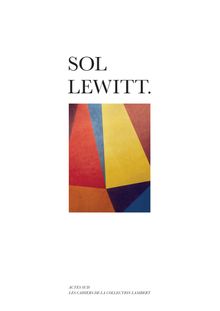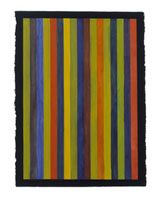| |||||||||||||||||||||||||
ARTIST MONOGRAPHS
|
|
STATUS: Out of stock indefinitely. |
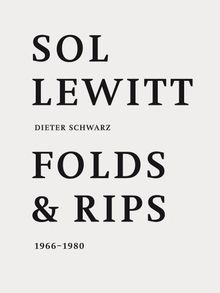 Sol LeWitt: Folds and Rips
Sol LeWitt: Folds and Rips
1966–1980
Published by Walther König, Köln.
Text by Dieter Schwarz.
In 1966, Sol LeWitt (1928–2007) conceived a new type of work that he described as “drawings without drawing,” in which he replaced the act of drawing itself by using various ways of folding paper. In 1969, he started to regularly produce what he called Folds, first as gifts to friends, then as works to be distributed by his dealers. In 1971 he added the Rips, drawings made of ripped paper.
LeWitt developed this extended approach to drawing from ripping papers of various sizes and colors to working with city maps and aerial photos of Florence, Manhattan and Chicago from which he removed various areas. This systematic approach, on which so much of LeWitt’s work is famously based, was also applied to the Folds and the Rips, and so they tended to be created in series.
The book presents these works for the first time, along with a historical essay by Dieter Schwarz and full-color reproductions of the Folds and the Rips.
PUBLISHER
Walther König, Köln
BOOK FORMAT
Paperback, 9.5 x 13 in. / 160 pgs / 150 color.
PUBLISHING STATUS
Pub Date 4/21/2020
Out of stock indefinitely
DISTRIBUTION
D.A.P. Exclusive
Catalog: SPRING 2020 p. 112
PRODUCT DETAILS
ISBN 9783960987116 FLAT40
List Price: $55.00 CAD $77.00
AVAILABILITY
Not available
STATUS: Out of stock indefinitely. |
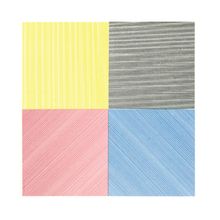 Sol LeWitt: Four Basic Kinds of Lines & Colour
Sol LeWitt: Four Basic Kinds of Lines & Colour
Published by Primary Information/Printed Matter, Inc..
Originally published in 1977, Four Basic Kinds of Lines & Colour is a classic artist’s book by preeminent conceptual artist Sol LeWitt (1928–2007). Featuring 34 pages of drawings, the work is an early example of LeWitt’s rigorous, algorithmic process in which a set of rules, applied to generate an image, are subsequently run through all of their permutations.
In the late 1960s LeWitt began applying this technique, first developed for his wall drawings, to artists’ books. In this publication, LeWitt demonstrates the 34 ways that basic lines (horizontal, vertical, left-facing diagonal and right-facing diagonal) can be rendered in four colors (red, yellow, blue and black), with each page displaying a single combination (for example, horizontal lines in blue).
The book is one of LeWitt’s signature bookworks, which in its original edition remains quite scarce, so this new facsimile edition is significant; almost none, if any, of his books (he produced over 50) have been reprinted.
PUBLISHER
Primary Information/Printed Matter, Inc.
BOOK FORMAT
Paperback, 8 x 8 in. / 36 pgs / 16 color / 16 bw.
PUBLISHING STATUS
Pub Date 9/17/2019
Active
DISTRIBUTION
D.A.P. Exclusive
Catalog: FALL 2019 p. 101
PRODUCT DETAILS
ISBN 9781732098664 TRADE
List Price: $16.00 CAD $24.95
AVAILABILITY
Out of stock
STATUS: Out of stock Temporarily out of stock pending additional inventory. |
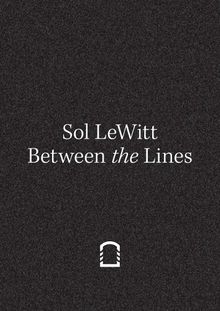 Sol LeWitt: Between the Lines
Sol LeWitt: Between the Lines
Published by Koenig Books.
Edited with text by Francesco Stocchi. Text by Rem Koolhaas, Adachiara Zevi.
Looking at a considerable range of works spanning the entire career of Sol LeWitt (1928–2007)—from seven of his famous Wall Drawings to sculptures such as Complex Form and Inverted Spiraling Tower, and including the photo-series Autobiography—this book explores the deeply intertwined relationship between LeWitt's work and architecture. Featuring a collaboration by the architect Rem Koolhaas—as a curator, for the first time ever—in dialogue with the curator Francesco Stocchi, Between the Lines addresses broad aspects of LeWitt's oeuvre, with the aim of moving beyond the divisions that traditionally separate architecture from art history (the flouting of which characterizes the artist's entire body of work). In particular, this book reformulates the still-popular assumption that an artwork must adapt to the architecture.
PUBLISHER
Koenig Books
BOOK FORMAT
Paperback, 7 x 9.5 in. / 320 pgs / 160 color.
PUBLISHING STATUS
Pub Date 6/26/2018
Out of stock indefinitely
DISTRIBUTION
D.A.P. Exclusive
Catalog: FALL 2018 p. 138
PRODUCT DETAILS
ISBN 9783960983446 FLAT40
List Price: $50.00 CAD $67.50
AVAILABILITY
Not available
STATUS: Out of stock indefinitely. |
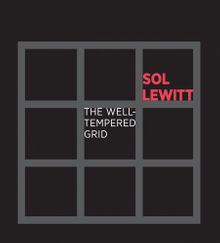 Sol LeWitt: The Well-Tempered Grid
Sol LeWitt: The Well-Tempered Grid
Published by Williams College Museum of Art.
Edited by Charles W. Haxthausen. Text by Charles W. Haxthausen, Christianna Bonin, Erica DiBenedetto.
PUBLISHER
Williams College Museum of Art
BOOK FORMAT
Paperback, 9.5 x 10.5 in. / 120 pgs / 95 color.
PUBLISHING STATUS
Pub Date 1/31/2013
Out of print
DISTRIBUTION
D.A.P. Exclusive
Catalog: SPRING 2013 p. 106
PRODUCT DETAILS
ISBN 9780913697313 TRADE
List Price: $35.00 CAD $40.00
AVAILABILITY
Not available
STATUS: Out of print | 00/00/00 For assistance locating a copy, please see our list of recommended out of print specialists |
 Sol LeWitt
Sol LeWitt
Published by JRP|Ringier.
Edited by Béatrice Gross. Text by Susanna Singer, John Hogan, Béatrice Gross, Lucy Lippard, Rosalind Krauss, Mel Bochner, Dan Graham, Robert Smithson.
In his 1967 "Paragraphs on Conceptual Art," Sol LeWitt set out the fundamental principle of his artistic practice: "In conceptual art the idea or concept is the most important aspect of the work.... The idea becomes a machine that makes the art." From the first wall drawing in 1968 until his death in 2007, LeWitt never ceased to develop new "machines," conceiving some 1,200 wall drawings and laying down the foundations of Conceptual and Minimalist art. LeWitt's wall drawings, always installed by assistants, eliminated any intermediary object (such as a canvas) between the work and its support, thereby dovetailing a sensuous material immediacy with a powerful Platonic detachment. His sculptural variations on grids, cubes and pyramids likewise project this moving simplicity and clarity.
Sol LeWitt (1928-2007) was born in Hartford, Connecticut, where he took art classes at the Wadsworth Atheneum. After receiving a BFA from Syracuse University he worked as a graphic designer in the office of architect I.M. Pei. In 1976, LeWitt cofounded the artists' book bookstore Printed Matter in New York, with Lucy Lippard. A retrospective of his wall drawings opened to the public in 2008 at MASS MoCA in North Adams, Massachusetts, where it will remain on view for 25 years.
PUBLISHER
JRP|Ringier
BOOK FORMAT
Hardcover, 10 x 11.25 in. / 326 pgs / illustrated throughout.
PUBLISHING STATUS
Pub Date 3/31/2013
Out of print
DISTRIBUTION
D.A.P. Exclusive
Catalog: SPRING 2013 p. 15
PRODUCT DETAILS
ISBN 9783037643068 TRADE
List Price: $55.00 CAD $65.00
AVAILABILITY
Not available
STATUS: Out of print | 00/00/00 For assistance locating a copy, please see our list of recommended out of print specialists |
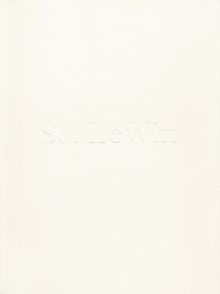 Sol Lewitt
Sol Lewitt
Artist's Portfolio
Published by La Fábrica.
PUBLISHER
La Fábrica
BOOK FORMAT
Paperback, 11.75 x 15.75 in. / 24 pgs / illustrated throughout.
PUBLISHING STATUS
Pub Date 3/31/2012
Out of print
DISTRIBUTION
D.A.P. Exclusive
Catalog: SPRING 2012 p. 137
PRODUCT DETAILS
ISBN 9788495471819 SDNR30
List Price: $65.00 CAD $87.00
AVAILABILITY
Not available
STATUS: Out of print | 00/00/00 For assistance locating a copy, please see our list of recommended out of print specialists |
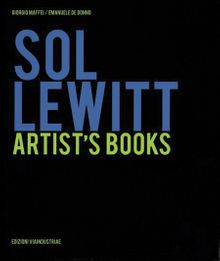 Sol LeWitt: Artist's Books
Sol LeWitt: Artist's Books
Published by Edizioni Corraini.
Text by Giorgio Maffei, Emanuele De Donno, Didi Bozzini, Cecilia Metelli, Marilena Bonomo.
PUBLISHER
Edizioni Corraini
BOOK FORMAT
Paperback, 6.25 x 7.5 in. / 144 pgs / 105 color / 150 bw.
PUBLISHING STATUS
Pub Date 2/28/2010
Out of stock indefinitely
DISTRIBUTION
D.A.P. Exclusive
Catalog: SPRING 2010 p. 70
PRODUCT DETAILS
ISBN 9788890345920 TRADE
List Price: $40.00 CAD $54.00
AVAILABILITY
Not available
STATUS: Out of stock indefinitely. |
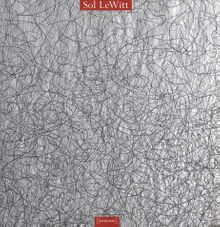 Sol LeWitt: Wall Drawings
Sol LeWitt: Wall Drawings
Published by Damiani.
Essay by Giovanni Maria Accame. Essay by Ester Coen.
PUBLISHER
Damiani
BOOK FORMAT
Paperback, 11 x 11 in. / 102 pgs / 24 color and 40 bw.
PUBLISHING STATUS
Pub Date 8/15/2006
Out of print
DISTRIBUTION
D.A.P. Exclusive
Catalog: FALL 2006 p. 115
PRODUCT DETAILS
ISBN 9788889431597 TRADE
List Price: $28.00 CAD $32.50
AVAILABILITY
Not available
STATUS: Out of print | 11/30/2012 For assistance locating a copy, please see our list of recommended out of print specialists |
 Sol Lewitt: Wall
Sol Lewitt: Wall
Published by Walther König, Köln.
Edited by Peter Pakesch. Essays by Paul Horwich, Marco de Michelis and Martin Prinzhorn.
PUBLISHER
Walther König, Köln
BOOK FORMAT
Flexi-bound, 8.75 x 11 in. / 84 pgs / 32 color / 26 bw
PUBLISHING STATUS
Pub Date 6/15/2004
Out of print
DISTRIBUTION
D.A.P. Exclusive
Catalog: SPRING 2005 p. 137
PRODUCT DETAILS
ISBN 9783883758107 SDNR30
List Price: $40.00 CAD $50.00
AVAILABILITY
Not available
STATUS: Out of print | 6/1/2005 For assistance locating a copy, please see our list of recommended out of print specialists |
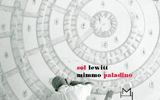 Sol Lewitt & Mimmo Paladino
Sol Lewitt & Mimmo Paladino
Published by Hopefulmonster.
Essays by Marilena Bonomo, Tullio Degennaro, Lia De Venere, Angela Paltera. Ludovico Pratesi and Adachiara Zevi.
PUBLISHER
Hopefulmonster
BOOK FORMAT
Paperback, 9.75 x 6.25 in. / 44 pgs / 12 color / 33 bw.
PUBLISHING STATUS
Pub Date 1/2/2004
No longer our product
DISTRIBUTION
D.A.P. Exclusive
Catalog: SPRING 2004
PRODUCT DETAILS
ISBN 9788877571779 TRADE
List Price: $18.00 CAD $20.00
AVAILABILITY
Not available
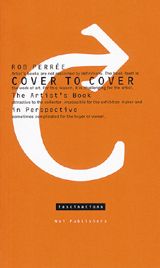 Cover To Cover
Cover To Cover
The Artist's Book in Perspective
Published by nai010 publishers.
Artwork by Ulises Carrión, Francesco Clemente, Hamish Fulton, Anselm Kiefer, Sol Lewitt, Richard Long. Text by Rob Perrée.
PUBLISHER
nai010 publishers
BOOK FORMAT
Paperback, 4.75 x 8 in. / 144 pgs / 32 bw.
PUBLISHING STATUS
Pub Date 3/2/2003
Out of print
DISTRIBUTION
D.A.P. Exclusive
Catalog: SPRING 2003
PRODUCT DETAILS
ISBN 9789056622824 TRADE
List Price: $24.95 CAD $27.50
AVAILABILITY
Not available
STATUS: Out of print | 8/1/2007 For assistance locating a copy, please see our list of recommended out of print specialists |
PUBLISHER
Museum of Contemporary Art, Chicago
BOOK FORMAT
Paperback, 6.25 x 7.75 in. / 136 pgs / 64 color.
PUBLISHING STATUS
Pub Date 6/2/1999
No longer our product
DISTRIBUTION
D.A.P. Exclusive
Catalog: FALL 1999
PRODUCT DETAILS
ISBN 9780933856585 TRADE
List Price: $25.00 CAD $30.00
AVAILABILITY
Not available
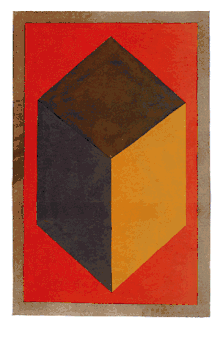 Sol Lewitt: 100 Cubes
Sol Lewitt: 100 Cubes
Published by Hatje Cantz.
Artwork by Sol Lewitt. Edited by Christina Bechtler. Contributions by Charlotte von Koerber.
PUBLISHER
Hatje Cantz
BOOK FORMAT
Paperback, 8.75 x 13 in. / 202 pgs / 100 color.
PUBLISHING STATUS
Pub Date 1/2/1996
Out of print
DISTRIBUTION
D.A.P. Exclusive
Catalog: SPRING 1996
PRODUCT DETAILS
ISBN 9783893227532 TRADE
List Price: $50.00 CAD $60.00
AVAILABILITY
Not available
STATUS: Out of print | 11/15/2006 For assistance locating a copy, please see our list of recommended out of print specialists |
